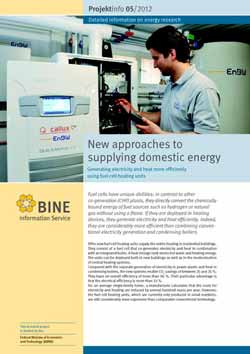Field-testing fuel cell heating units

The new BINE-Projektinfo brochure “New approaches to supplying domestic energy” (05/2012)<br>
Fuel cells enable electricity and heat to be generated in a single process. In contrast to previous domestic heating systems, fuel cell heating units can supply both existing and new buildings with heat while also generating electricity as well.
The new BINE-Projektinfo brochure “New approaches to supplying domestic energy” (05/2012) presents the initial findings from a research project in which natural gas-operated fuel cell heating units are being tested with private customers under realistic conditions. The aim is to further improve the systems in both technical and economic terms.
For a successful market introduction, the fuel cell heating units still need to be improved further in terms of their service life, efficiency and costs. Nevertheless, they have been able to make considerable progress during the last few years: the lifetime of the systems has now doubled to 20,000 hours and is increasing further. Initial small-scale production runs for field tests have enabled materials and production conditions to be optimised, including for the supply chains.
The investment and operating costs have also been reduced as a result. 230 systems are being field-tested that have now completed around 1,000,000 operating hours in total. On average the devices have completed 4,000 to 6,000 operating hours, whereby individual units have already completed 15,000 hours (as of May 2012).
The field test will make it possible to determine whether the technology has reached maturity. In addition, specifications, standards and training materials are being developed for specialist installers. Two different types of fuel cell systems are being used: the polymer electrolyte membrane fuel cell (PEMFC) works in a temperature range around 80°C and the solid oxide fuel cell (SOFC) works at 600°C.
Press contact
Uwe Milles
presse(at)bine.info
About BINE Information Service
Energy research for practical applications
The BINE Information Service reports on energy research topics, such as new materials, systems and components, as well as innovative concepts and methods. The knowledge gained is incorporated into the implementation of new technologies in practice, because first-rate information provides a basis for pioneering decisions, whether in the planning of energy-optimised buildings, increasing the efficiency of industrial processes, or integrating renewable energy sources into existing systems.
About FIZ Karlsruhe
FIZ Karlsruhe – Leibniz Institute for Information Infrastructure is a not-for-profit organization with the public mission to make sci-tech information from all over the world publicly available and to provide related services in order to support the national and international transfer of knowledge and the promotion of innovation.
Our business areas:
• STN International – the world’s leading online service for research and patent information in science and technology
• KnowEsis – innovative eScience solutions to support the process of research in all its stages, and throughout all scientific disciplines
• Databases and Information Services – Databases and science portals in mathematics, computer science, crystallography, chemistry, and energy technology
FIZ Karlsruhe is a member of the Leibniz Association (WGL) which consists of 87 German research and infrastructure institutions.
Media Contact
More Information:
http://www.bine.info/enAll latest news from the category: Power and Electrical Engineering
This topic covers issues related to energy generation, conversion, transportation and consumption and how the industry is addressing the challenge of energy efficiency in general.
innovations-report provides in-depth and informative reports and articles on subjects ranging from wind energy, fuel cell technology, solar energy, geothermal energy, petroleum, gas, nuclear engineering, alternative energy and energy efficiency to fusion, hydrogen and superconductor technologies.
Newest articles

How 3D printers can give robots a soft touch
Soft skin coverings and touch sensors have emerged as a promising feature for robots that are both safer and more intuitive for human interaction, but they are expensive and difficult…

Oxygen vacancies mediated ultrathin Bi4O5Br2 nanosheets
… as efficient piezocatalyst for synthesis of H2O2 from pure water. As an important chemical raw material, hydrogen peroxide (H2O2) is widely applied in various aspects of industry and life….

Atom-by-atom: Imaging structural transformations in 2D materials
Silicon-based electronics are approaching their physical limitations and new materials are needed to keep up with current technological demands. Two-dimensional (2D) materials have a rich array of properties, including superconductivity…





















